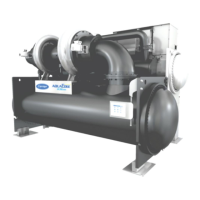107
Access to low-voltage electrical equipment is dangerous and can result in death or serious injury. Personnel
working on the control boxes must be qualified to work on low-voltage installations in accordance with the safety
regulations applicable at the site. It must be authorized for the work and familiar with the equipment and the
installation, as well as the instructions and safety measures described in this document.
Never work on a unit that is energized.
Do not work on any electrical components, until the main unit power supply has been switched off using the
disconnect switch(es) integrated into the control box(es).
During maintenance periods lock the power supply circuit upstream of the unit in the open position.
ATTENTION: 19DV power cabinets are equipped with capacitor coils with a discharge time after a power cut of five
minutes. If the discharge circuit in the capacitor fails it is not possible to define the discharge time.
After cutting the power supply to the control box, wait five minutes before accessing the control box.
Ensure that there is no power supply to any conducting parts of the power circuit that are accessible during the
work.
WARNING: On certain installations linked to a specific application (datacenter, industrial process ...), the 19DV can be
equipped with a second 400/3/50 emergency power supply to permanently supply the following equipment:
- control of the drive
- chiller control
- the purge group
- the refrigerant pump
Even if the main power is turned off in the VFD compartment, when the VFD compartment is open, the 400V backed up
power supply is present. Refer to the labels on the outside and inside of the compartment as well as on the equipment
mentioned above for the precautions to be used and identify possible risks.
Wait five minutes before accessing the control box after disconnecting the power supply.
Ensure that no conductive part of the supply circuit accessible during the operation is energized.
These are special instructions to disassemble a chiller equipped with VFD :
IMPORTANT: Only a qualified technician can carry out these operations.
WARNING: Do not attempt to disconnect the flanges, if the chiller is under pressure. The chiller has not been purged, and
this can cause injuries or damage to the machine.
Ensure that the power supply has been disconnected and that all safety measures are in place, before removing the VFD
box. This procedure minimizes the number of sensors and cables that need to be disconnected.
WARNING: Do not disconnect the evaporator and condenser before VFD has been disconnected and removed. VFD box
has a high-level centre of gravity and can tip over when the heat exchangers are disconnected, which can lead to material
damage and/or serious injuries to personnel.
WARNING: Do not attempt to remove the VFD, before closing the shut-off valve on the refrigerant circuit. If this warning
is not observed, the VFD removal will lead to a significant and uncontrolled refrigerant leak. A refrigerant leak can
damage the machine and displace oxygen, which can cause asphyxiation.
For commissioning, installation and operation instructions for units with VFD LF2 and PIC5+ control, refer to chapter 8
of the Carrier 19XR / 19XRV manual.
CAUTION : The motor leads must be disconnected from the VFD before an insulation test is performed. The voltage
generated from the tester can damage the drive components.
CAUTION : Failure to follow these procedures may result in personal injury or damage to equipment.
To avoid an electric shock hazard, verify that the voltage on the bus capacitors has discharged completely before servicing.
Check the DC bus voltage at the power terminal block by measuring between the +DC and –DC terminals, between the
+DC terminal and the chassis, and between the –DC terminal and the chassis. The voltage must be zero for all three
measurements.
WARNING: DC bus capacitors retain hazardous voltages after input power has been disconnected. An isolated multimeter
will be needed to measure DC bus voltage and to make resistance checks.
After disconnecting input power, wait 5 minutes for the DC bus capacitors to discharge and then check the voltage with a
voltmeter rated for the DC bus voltage to ensure the DC bus capacitors are discharged before touching any internal
components. Failure to observe this precaution could result in severe bodily injury or loss of life.
WARNING : The disconnect on the power cabinet front panel does not always de-energize all internal circuits. Open all
internal and remote disconnects before servicing the starter. Failure to follow this procedure may result in personal injury
by electric shock.

